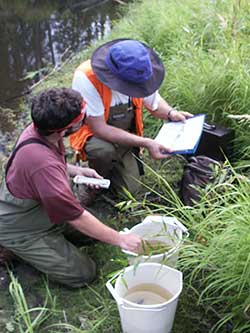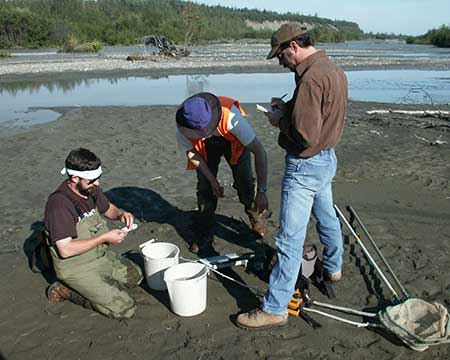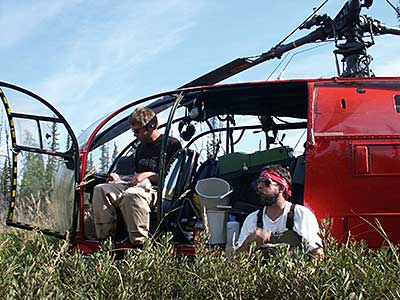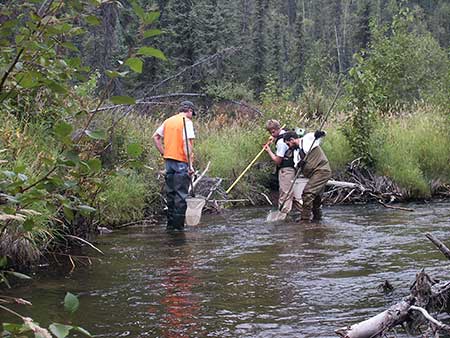Alaska Fish & Wildlife News
June 2015
Documenting and Protecting Salmon Streams
Anadromous Waters Atlas and Catalog

Before Alaska became a state, territorial laws were in place to protect anadromous fish streams. Anadromous fish are born in freshwater, migrate to saltwater to live most of their lives, then return to freshwater to spawn. These include salmon, trout, char, whitefish, lamprey and smelt.
With statehood, various territorial provisions were replaced with state statutes that broadened the protection afforded anadromous species in state waters. Subsequent legislation passed in 1966 led to a formal listing of the state’s anadromous rivers, lakes, and streams. Alaska Statute 16.05.871 requires that the Alaska Department of Fish and Game specify the rivers, lakes, and streams - or parts of them that are important for spawning, rearing, or migration of anadromous fishes - and an official “catalog” was created, with a related atlas. Officially known as the Catalog of Waters Important for Spawning, Rearing, or Migration of Anadromous Fishes, and, An Atlas to the Catalog of Waters Important for Spawning, Rearing, or Migration of Anadromous Fishes, they are now referred to as the Catalog and Atlas or collectively as the Anadromous Waters Catalog.
The Catalog provides a legal listing of water bodies important to the spawning, rearing, or migration of anadromous fish. The Atlas displays maps showing the location, the anadromous fish species found, and the life stages documented in those water bodies. The Catalog lists almost 19,000 streams, rivers, or lakes in Alaska and more are added each year. Based on thorough surveys of a few drainages, we believe that this number represents less than 50 percent of the streams, rivers, and lakes actually used by anadromous species in Alaska.

To be protected, water bodies must be documented as supporting some life function of an anadromous fish species and be officially listed in the Catalog. Water bodies that are not in the Catalog and Atlas are not afforded protection under existing state statutes, even if anadromous fish are known to be present. Changes to the Atlas and Catalog are accomplished through a nomination process. Nominations are a key component of the department’s authority to protect water bodies that support anadromous fish.
Most nominations come from department fish or habitat biologists. Others are received from biologists with other state and federal agencies, staff of non-government organizations, businesses and individuals. On average, the department receives about 800 nominations a year. Many of the nominations from outside the department are the direct result of increased collaboration between the department’s Anadromous Waters Catalog and Fish Resource Permit programs. Recently, Fish Resource Permit stipulations were revised to include language requiring those who are issued a permit to work closely with the department to update the Catalog when new anadromous fish species or previously undocumented life stages of anadromous fish are found. This change, in combination with department’s efforts to thoroughly review permit data, has increased awareness of the anadromous waters program and led to an increase in the number of nomination submissions.

Nominations may be submitted for purposes of (1) adding new water bodies (2) adding species to previously cataloged streams, (3) extending species distribution in cataloged water bodies, (4) deleting water bodies or parts of them, (5) updating survey data on cataloged water bodies, or (6) revising stream channels, labeling errors, or identifying barriers to fish movement. Nominations should provide adequate information to substantiate the requested change. Once received, the Division of Sport Fish is responsible for reviewing and tracking anadromous water body nominations. The anadromous waters project biologist prepares mapping instructions, which are then reviewed by department staff prior to inclusion in the Catalog and updating of Atlas maps. Once revised maps are drafted and have undergone department, public, and regulatory review, they are adopted into regulation. Regulatory update of the Anadromous Waters Catalog is scheduled to occur once a year.
The divisions of Sport Fish and Habitat have separate, complementary responsibilities for the Anadromous Waters Catalog Program. The Division of Sport Fish maintains the biological and geographic data which are used to create the Anadromous Waters Atlas maps and Catalog. The Division of Habitat conducts the regulatory process for adopting the Catalog into state regulation. A representative from each division is responsible for the final authorization of each nomination.

Presently Catalog data are available in hard copy, PDF and shape files or geodatabases that can be imported into mapping software such as ARCMAP, or Google Earth™. Mapping software has improved the department’s ability to make the Catalog available online. Website users can overlay and view resident fish and culvert location data using topographical or satellite imagery. Atlas maps and regional catalogs, along with shape files, geodatabase, and KMZ files are also available for download through the department’s web site. Additional information, downloadable copies of nomination forms, and all publicly available Anadromous Waters Catalog information can be found at: http://www.adfg.alaska.gov/sf/SARR/AWC/ .
J. Johnson is a Habitat Biologist based in Anchorage who enjoys gardening, reading, cross country skiing, and walking area trails with his 4 year old Chesapeake Bay Retriever, Kleio.
Subscribe to be notified about new issues
Receive a monthly notice about new issues and articles.
